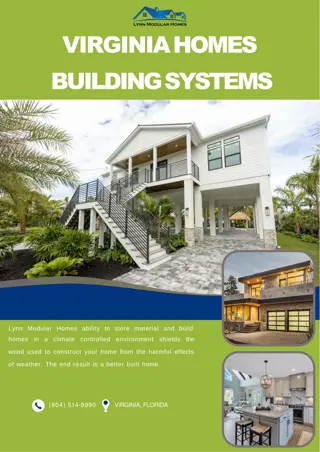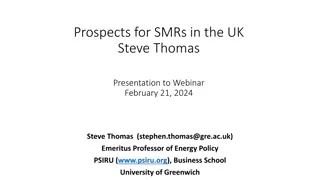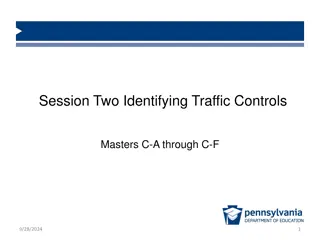Risks and Warning Signs of Small Modular Reactors (SMRs)
Small Modular Reactors (SMRs) are nuclear reactors with a power capacity of 300 megawatts or smaller. Despite potential benefits, there are significant risks associated with SMRs, including cost overruns, schedule delays, lack of construction, and high power prices. The industry's track record raises concerns about the feasibility of SMRs for addressing climate change. Government and industry claims of cheap atomic power are being challenged by the reality of escalating costs. Stakeholders should exercise caution in considering SMRs as a viable energy solution.
Download Presentation

Please find below an Image/Link to download the presentation.
The content on the website is provided AS IS for your information and personal use only. It may not be sold, licensed, or shared on other websites without obtaining consent from the author.If you encounter any issues during the download, it is possible that the publisher has removed the file from their server.
You are allowed to download the files provided on this website for personal or commercial use, subject to the condition that they are used lawfully. All files are the property of their respective owners.
The content on the website is provided AS IS for your information and personal use only. It may not be sold, licensed, or shared on other websites without obtaining consent from the author.
E N D
Presentation Transcript
SMR Risks & Warning Signs Presentation for MEIC & the Montana Chapter of the Sierra Club David Schlissel, IEEFA Director of Resource Planning Analysis January 11, 2024 1 www.ieefa.org
What is a small modular reactor (SMR)? SMRs are generally defined as reactors that are 300 megawatts (MWe) or smaller; this compares to the 600-1135 MWe range for most current U.S. reactors Designs can include a single reactor or multiple units grouped together NuScale s reactor modules are 77 MWe each, and can be grouped in plants of up to 12 modules not necessarily small GE-Hitachi s reactor is a single 300 MWe unit but also not necessarily small if grouped Modular refers to the idea that plants would be fabricated in factories, then assembled at site Designs include scaled-down versions of existing boiling and pressurized water reactors, as well as other proposals for technologies that previously have been tried and failed or have never been tried at all ~80 SMR designs have been proposed 2 www.ieefa.org
Key SMR Risks and Warning Signs 1. U.S. nuclear industry has repeatedly been unable to meet estimated costs and schedules hundreds of billions of dollars in cost overruns and years-long schedule delays 2. None of the SMR designs currently being marketed have been built 3. None have been licensed in the U.S. or in Canada 4. Some proposals have exotic designs that have never been tried or have failed in the past 5. Not good tools for fighting climate change too expensive, take too long to build 6. Recent cancellation of proposed first NuScale SMR and tanking of NuScale s stock price warning signs for governments, utilities, ratepayers, and private investors 7. Key warning sign - except for NuScale, SMR vendors are refusing to make estimated construction costs public 8. Increasing competition from declining cost renewable sources + storage 3 www.ieefa.org
How Expensive Can SMR Power Get? When the NuScale SMR was cancelled in November, its target price of power was $119 per megawatt hour (MWh), not including Inflation Reduction Act subsidies, & $89 per MWh with the subsidies But that s not as high as the price of power from an SMR can get For example, the CEO of Constellation Energy Corporation, which owns the most nuclear plants in the U.S., sees a price of $150 to $160 per MWH for the power from a new SMR. And wants no piece of one without a guaranteed contract that someone will pay that much for power from the plant The CEO of NextEra Energy has similarly expressed skepticism about SMRs [SMRs] are going to be very expensive, and then you re going to be taking a bet on the technology Right now, I look at SMRs as an opportunity to lose money in smaller batches But $160 is not a cap - SMR power prices could be even higher, perhaps significantly higher 4 www.ieefa.org
Initial Government and Industry Claim Atomic power would be too cheap to meter 5 www.ieefa.org
Reality After 1970 Reactors Became Too Expensive to Build Results of 1986 DOE study understated cost and schedule overruns: (1) overnight costs don t include financing costs or inflation & (2) many of most expensive reactors were not included 6 www.ieefa.org
What Did the Nuclear Industry Say After the First Wave of Reactors Were so Expensive? The industry claimed: New reactor designs would benefit from modular construction in terms of both shorter construction time and lower costs. (1) But these benefits did not materialize and (2) This is nearly identical to what current SMR vendors are claiming today for their projects 7 www.ieefa.org
Did This Lead to Less Expensive Nuclear Units? No. Over 20 new reactor projects proposed Only 4 began construction Only 2 are being finished at the Vogtle Nuclear Project in Georgia 8 www.ieefa.org
The Vogtle Experience Much Worse than Projected 9 www.ieefa.org
Who Will Bear Most of Vogtles Higher Cost? Ratepayers of Vogtle s owners will have to bear the greatest part of the cost overrun Georgia Power Company will bear only a small portion of its 45.7% of the project s ultimate cost The ratepayers of the other three owners likely will have to bear all of their shares of the project s higher cost 10 www.ieefa.org
What Claims Does the Nuclear Industry Now Make for SMRs After the Experience at Vogtle? The industry s current claims for SMRs are mostly the same as they were before Vogtle Simplified, modular, ultra compact nuclear island (costliest portion of any reactor) reduces construction costs/schedule. Westinghouse, 2023 The industry and its supporters also claim that by building lots of SMRs, the cost per MWh will decline that is, there will be learning curve that will lead to cost reductions 11 www.ieefa.org
Have the Estimated Costs of Any Proposed SMRs Gone Up? Yes. Estimated cost of NuScale s proposed SMR for Utah more than doubled before it was cancelled in November 2023 12 www.ieefa.org
As the Estimated Cost of Building the NuScale SMR Rose, So Did Its Projected Price of Power $119 per MWh would not have been the final price for the power from the NuScale SMR The price of power would have continued to go up had the project not been cancelled 13 www.ieefa.org
Have Investors Been Hurt by the Increasing Cost of NuScales SMR? Yes. NuScale s stock price has cratered from a high of $14.87 per share in mid- August of 2022 to a current price of $2.41 14 www.ieefa.org
Is There Any Evidence that SMRs Will Be Less expensive than Earlier Reactors? No. Despite proponents claims, the estimated cost of NuScale s SMR was already as high as the Vogtle project when it was cancelled with more than 7 years left before construction is scheduled to be completed plenty of time for the cost to go even higher. 15 www.ieefa.org
Was Concern over Rising Construction Costs and Power Prices Why the NuScale SMR Was Cancelled? Yes. Project was cancelled because NuScale and UAMPS (Utah Associated Municipal Power Systems) were unable to find enough parties to sign contracts to pay for the power from the SMR By 2023 NuScale and UAMPS were promising a target price of $89 per MWh but this was just an estimated target. Not a guaranteed price The contract required parties who remained in the project after a license was granted by the Nuclear Regulatory Commission to pay all the actual costs of the SMR even if it was not finished, never provided any power, or was damaged or destroyed New parties did not want to sign a blank check with no guarantee as to how high the ultimate cost of the project would go 16 www.ieefa.org
SMRs Not Good Tools for Fighting Climate Change Take too long to build faster & cheaper options can be online much sooner Power even more expensive if reactors cycled Units on the coast threatened by ocean level rise and severe storms Inland units threatened by storms & more severe droughts from global warming Will compete with renewables for space on transmission lines 17 www.ieefa.org
Power From SMRs Will Be More Expensive than Power from Renewable Resources Sources: NuScale Power, UAMPS and National Renewable Energy Lab s 2023 Annual Technology Baseline report. 18 www.ieefa.org
What About the Estimated Costs of Other Proposed SMRs? NuScale and UAMPS cited higher interest rates and escalation of construction commodity prices as reasons why the cost of its proposed SMR increased by 75% just between 2021 & January 2023 Reasonable to expect that the same factors will lead to similar increases in the cost of other SMRs especially those with more exotic designs Warning Sign - other SMR marketers have so far been able keep current project cost and schedule estimates secret from the public and investors 19 www.ieefa.org
Whats Going On With The Natrium Reactor? TerraPower refuses to provide any publicly-available cost estimate and meaningful estimated in-service date PacifiCorp says that it doesn t have any detailed cost estimates for Natrium in its IRP instead it uses proxy values that do not reflect finalized costs Yet PacifiCorp refuses to reveal what those proxy values are Gates and TerraPower talk vaguely about when the TerraPower plant will be in service However, a recent report for large industrial users of electricity in Norway by the RystadEnergy consulting firm expresses doubt that the Natrium reactor will be in service by 2040 Prudent resource planning by PacifiCorp and the Wyoming PSC should include complete transparency about the currently estimated costs and in-service schedule for the Natrium 20 www.ieefa.org
Is It Reasonable to Expect That the Costs of Building SMRs Will Decline as More Are Built? Proponents of SMRs assume that there will be a learning curve which will make the costs of building SMRs decline over time. This is just an assumption it certainly hasn t happened in the U.S. and credible analyses raise doubt whether it has happened elsewhere As noted earlier, the same prediction was made for the Vogtle Nuclear project Even if there is such a learning curve, it is unknown how quickly the cost of building SMRs will decline or by how much without offering any real evidence, SMR proponents assume steep declines, e.g., where each successive SMR is 10% cheaper than the last Also, if there such a learning curve, it s slope will depend on how many SMRs of each specific design are built and whether any major flaws in that design are found during construction or operation - these are currently unknowable especially with so many different designs being marketed 21 www.ieefa.org
For More Information Contact David Schlissel at dschlissel@IEEFA.org IEEFA reports on SMR risks available at www.ieefa.org/smr SMRs Too late, too expensive, too risky and too uncertain Eye-popping new cost estimates released for NuScale small modular reactor NuScale Power, the canary in the small modular reactor market Sign up to get new research from IEEFA when it s available 22 www.ieefa.org























